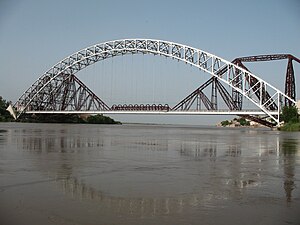Ayub Bridge
Coordinates: 27 ° 41 ′ 38 ″ N , 68 ° 53 ′ 17 ″ E
| Ayub Bridge | ||
|---|---|---|
| Ayub Bridge in front of the darker Lansdowne Bridge | ||
| use | Railway bridge | |
| Crossing of | Indus | |
| place | Sukkur - Rohri | |
| construction | Steel arch bridge | |
| overall length | 310 m | |
| Number of openings | a | |
| Longest span | 245 | |
| Construction height | 75 m | |
| start of building | 1959 | |
| opening | May 6, 1962 | |
| planner | Robinson & Steinman | |
| location | ||
|
|
||
The Ayub Bridge in Pakistan is a railway bridge over the Indus , which connects the cities of Sukkur in the province of Sindh on the northwest and Rohri on the southeast bank of the river. It stands directly next to the Lansdowne Bridge , which it replaced from 1962 in its function as part of the Lahore - Karachi railway line .
It is named after the then Pakistani President Field Marshal Muhammed Ayub Khan , who opened it on May 6, 1962.
description
The single-track bridge was built between 1959 and 1960 by the equally renowned British bridge construction company Dorman Long according to plans by the US firm Robinson & Steinman . To what extent David B. Steinman dealt with the planning shortly before his death is not known. The bridge also is somewhat similar to Dorman Long in today's 1935 Zimbabwe started Birchenough Bridge .
The Ayub Bridge consists of a large steel truss arch, more precisely of two arched truss girders that are connected and stiffened by diagonal crossbeams, from which the bridge panel is suspended with wire ropes . The arch has a span of 245 m (806 ft), the bridge structure is a total of 310 m long.
Web links
Individual evidence
- ↑ Sarfaraz Memon: British engineering: Ayub Bridge turns 50. Article of May 7, 2012 on tribune.com

